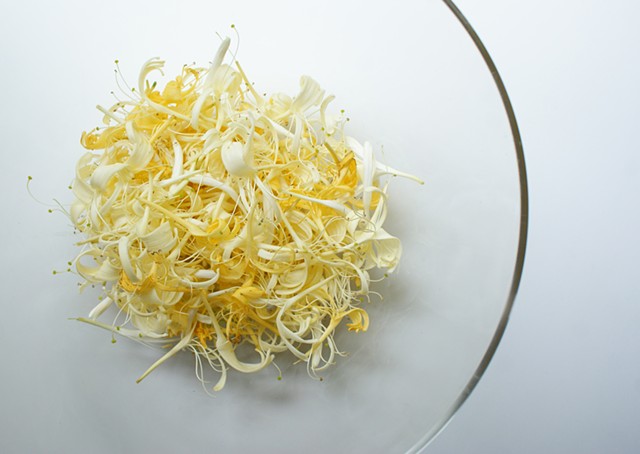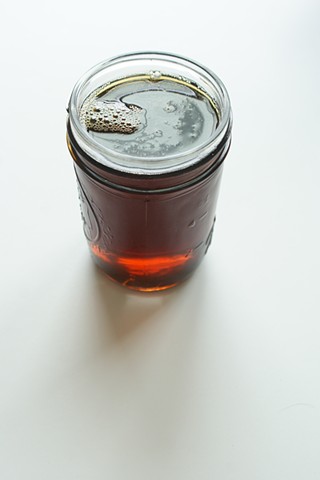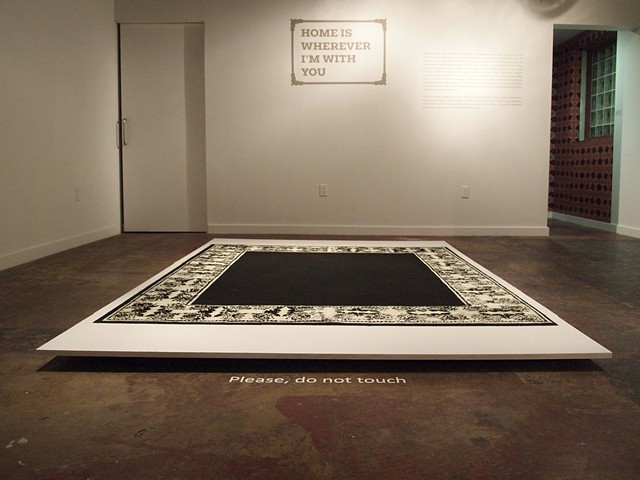Home is Wherever I'm With You
“Working in concert, European weeds and European humans proved formidable ecological imperialists, rapidly driving out native species and altering the land to suit themselves. The new plant species thrived because they were consumate cosmopolitans, opportunists superbly adapted to travel and change.”
-Michael Pollan, The Botany of Desire
In keeping with my interest in plant communities and their ability to so often reflect a congruent history of human migration and settlement, the work included in the exhibition is a study of two plants, both imports and each responsible in their own way for transforming the landscape of the Mississippi River Basin in Southern Illinois. The first, Honeysuckle (Lonicera japonica) and the second, Horseradish (Armoracia rusticana) are consummate examples of non-indigenous species having put down roots and proceeding to thrive beyond their respective places of origin. Each was selected firstly for its prevalence in the region, Honeysuckle as an escaped garden specimen which has naturalized and since been classified as an invasive, Horseradish thriving annually due to its value as a commodity crop especially suited to the river bottom conditions of the region. Secondly, each was chosen for their flawlessly illustrating an imported plant’s ability to acclimate to a new environment in which human agency has deposited it, and thus transforming the place in which it has arrived. Finally, both possess the transportive and elusive quality of scent, from either bloom or root.
A Brief History of Horseradish and Honeysuckle:
Originally from Central Europe, Horseradish (Armoracia rusticana) consumption spread westward to England, where it was consumed and later transported to North America by early settlers. Cultivated in the colonies, it was common in the northeast by 1806, and it grew wild near Boston by 1840. Commercial cultivation in America began in the mid 1850s, when immigrants started horseradish farms in the Midwest. By the late 1890s, a thriving horseradish industry had developed in an area of fertile soil on the Illinois side of the Mississippi River. It is now found in most commercially produced wasabi. The Japanese condiment, although traditionally prepared from the root of the wasabi plant, is now usually made with horseradish due to the scarcity of the wasabi plant. Hence most “wasabi” consumed is a by-product of horseradish, much of which is grown in Southern Illinois. Japanese Honeysuckle (Lonicera japonica) is a perennial vine native to Eastern Asia including Japan, Korea, and China. Admired for its fruity vanilla fragrance and attractive yellow and white blooms, the species was introduced to North America in the early 1800’s as an ornamental plant, for erosion control, and wildlifeforage/cover. It has since been classified as a noxious weed and invasive species due to its proliferation and ability to
displace native species.
The resulting installation is manifest as an ephemeral floor-based drawing resembling an oriental rug composed of a sifted ground of charcoal made from harvesting and processing the woody base of the Honeysuckle vine.
Accompanying this is an overlay of sifted wasabi powder which creates a botanical pattern of stylized Honeysuckle and Horseradish in the spirit of late- Victorian textile designs of William Morris. The reference to Morris’ tapestries and the late-Victorian era is the chronological correspondence of his life and career with the importation of the species under focus.
The representation of a rug is a suggestion of domesticity and home, underscoring that both species have had the ability to be uprooted and not only adjust, but thrive in a new ecosystem (or home). Yet, particularly in this instance, Horseradish, as well as many other introduced plant species that have been introduced to North America have been so because of their ability to conjure cuisines of home in a foreign land and thus memories of a home elsewhere.















